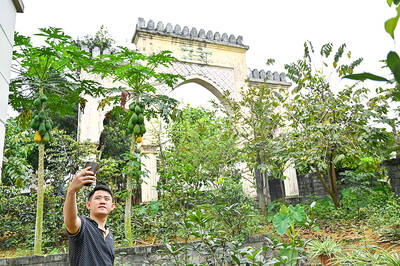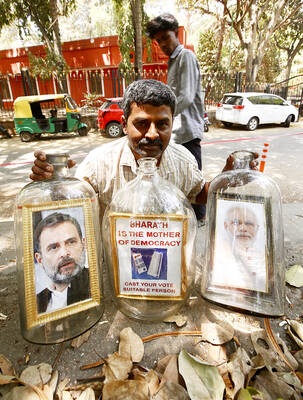Guatemalan soldiers on Saturday blocked part of a caravan of as many as 9,000 Honduran migrants at a point not far from where they entered the country seeking to reach the US border.
The soldiers, many wearing helmets and wielding shields and sticks, formed ranks across a highway in Chiquimula, near the Honduras border, to block the procession of migrants.
Guatemala’s immigration agency distributed a video showing a couple of hundred people scuffling with soldiers, pushing and running through their lines, even as troops held hundreds more back.
Guatemalan President Alejandro Giammattei in a statement urged Honduran authorities “to contain the mass exit of its inhabitants.”
On Friday, the migrants entered Guatemala by pushing past about 2,000 police and soldiers posted at the border; most entered without showing a negative COVID-19 test result that Guatemala requires.
“The government of Guatemala regrets this violation of national sovereignty and calls on the governments of Central America to take measures to avoid putting their inhabitants at risk amid the health emergency due to the pandemic,” Giammattei said.
Guatemala has set up almost a dozen control points on highways, and might start busing more migrants back to Honduras, as it has done before, arguing they pose a risk to themselves and others by traveling during the pandemic.
Governments throughout the region have made it clear they will not let the caravan through.
Mexico continued to drill thousands of National Guard members and immigration agents on its southern border, in a show of force meant to to discourage the caravan from crossing into Mexico.
On Friday night, two groups of more than 3,000 Honduran migrants each pushed their way into Guatemala without registering, part of a larger migrant caravan that had left the Honduran city of San Pedro Sula before dawn.
A third group entered Guatemala on Saturday.
The migrants are trying to cross Guatemala to reach Mexico, driven by deepening poverty and the hope of a warmer reception if they can reach the US border.
However, several previous attempts at forming caravans have been broken up by Mexico, Guatemala and Honduras.
On Friday, the migrants set out at about 4am from San Pedro Sula, young men and entire families carrying sleeping children. Some quickly caught rides, while others walked along the highway escorted by police.
Mainor Garcia, a 19-year-old laborer from San Pedro Sula, carried a purple knapsack as he walked along the highway.
He said he was scared about the journey, but willing to run the risk.
“[Hurricanes] Eta and Iota destroyed all of our homes,” he said.
The International Committee of the Red Cross said in a statement on Friday that “the combination of COVID-19, social exclusion, violence and climate-related disasters that occur at the same time with a magnitude seldom seen before in Central America raises new humanitarian challenges.”
The migrants leave with little certainty about how far they will make it. Regional governments have appeared more united than ever in stopping their progress.
Francisco Garduno Yanez, head of Mexico’s National Immigration Institute, said in a statement that his country has “to guarantee our national territory” and called for “an orderly, safe and legal migration with respect for human rights and with humanitarian policies.”

Le Tuan Binh keeps his Moroccan soldier father’s tombstone at his village home north of Hanoi, a treasured reminder of a man whose community in Vietnam has been largely forgotten. Mzid Ben Ali, or “Mohammed” as Binh calls him, was one of tens of thousands of North Africans who served in the French army as it battled to maintain its colonial rule of Indochina. He fought for France against the Viet Minh independence movement in the 1950s, before leaving the military — as either a defector or a captive — and making a life for himself in Vietnam. “It’s very emotional for me,”

Indian Prime Minister Narendra Modi reaffirmed his pledge to replace India’s religion-based marriage and inheritance laws with a uniform civil code if he returns to office for a third term, a move that some minority groups have opposed. In an interview with the Times of India listing his agenda, Modi said his government would push for making the code a reality. “It is clear that separate laws for communities are detrimental to the health of society,” he said in the interview published yesterday. “We cannot be a nation where one community is progressing with the support of the Constitution while the other

The Chinese Communist Party’s (CCP) Central Committee is to gather in July for a key meeting known as a plenum, the third since the body of elite decisionmakers was elected in 2022, focusing on reforms amid “challenges” at home and complexities broad. Plenums are important events on China’s political calendar that require the attendance of all of the Central Committee, comprising 205 members and 171 alternate members with Chinese President Xi Jinping (習近平) at the helm. The Central Committee typically holds seven plenums between party congresses, which are held once every five years. The current central committee members were elected at the

CODIFYING DISCRIMINATION: Transgender people would be sentenced to three years in prison, while same-sex relations could land a person in jail for more than a decade Iraq’s parliament on Saturday passed a bill criminalizing same-sex relations, which would receive a sentence of up to 15 years in prison, in a move rights groups condemned as an “attack on human rights.” Transgender people would be sentenced to three years’ jail under the amendments to a 1988 anti-prostitution law, which were adopted during a session attended by 170 of 329 lawmakers. A previous draft had proposed capital punishment for same-sex relations, in what campaigners had called a “dangerous” escalation. The new amendments enable courts to sentence people engaging in same-sex relations to 10 to 15 years in prison, according to the